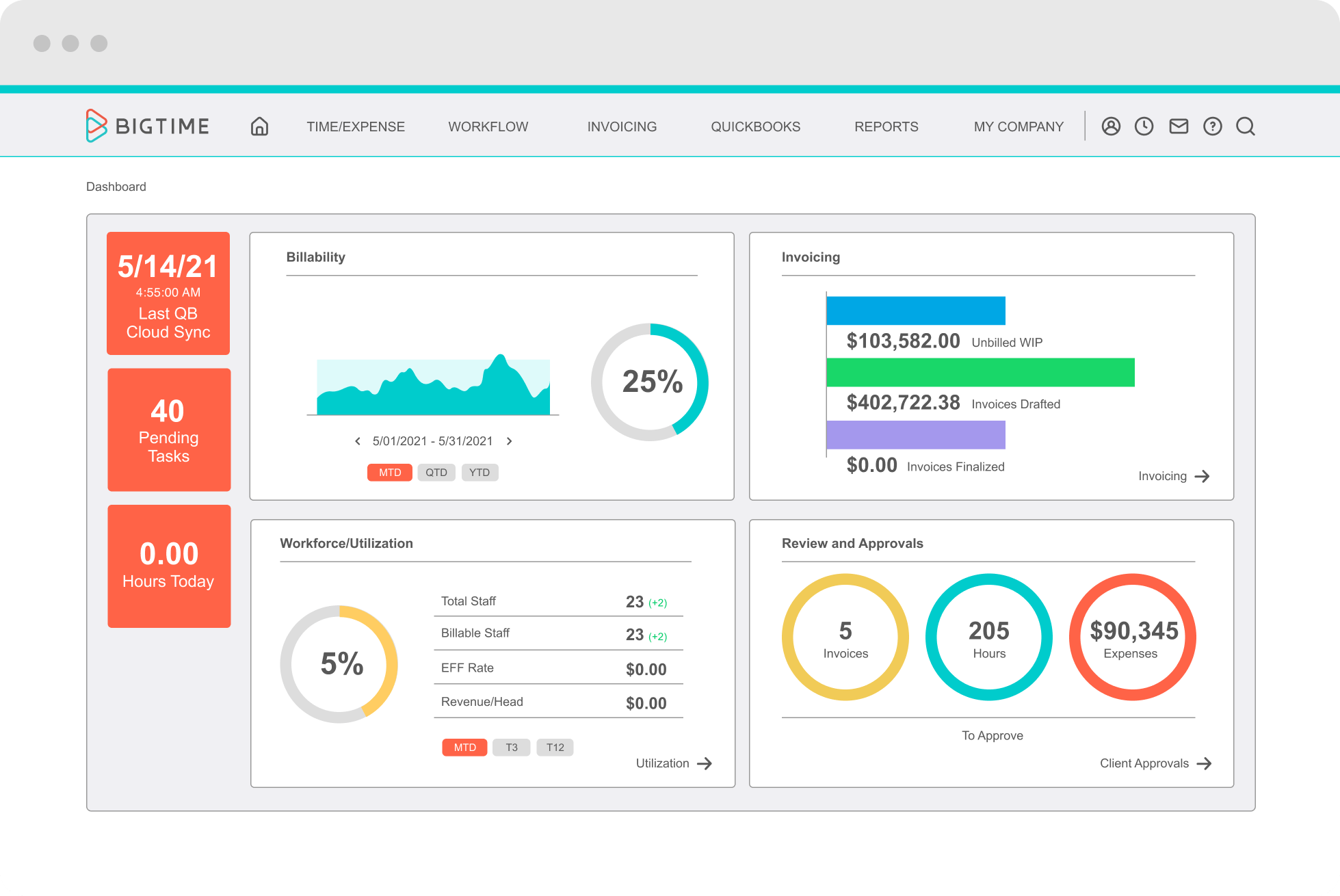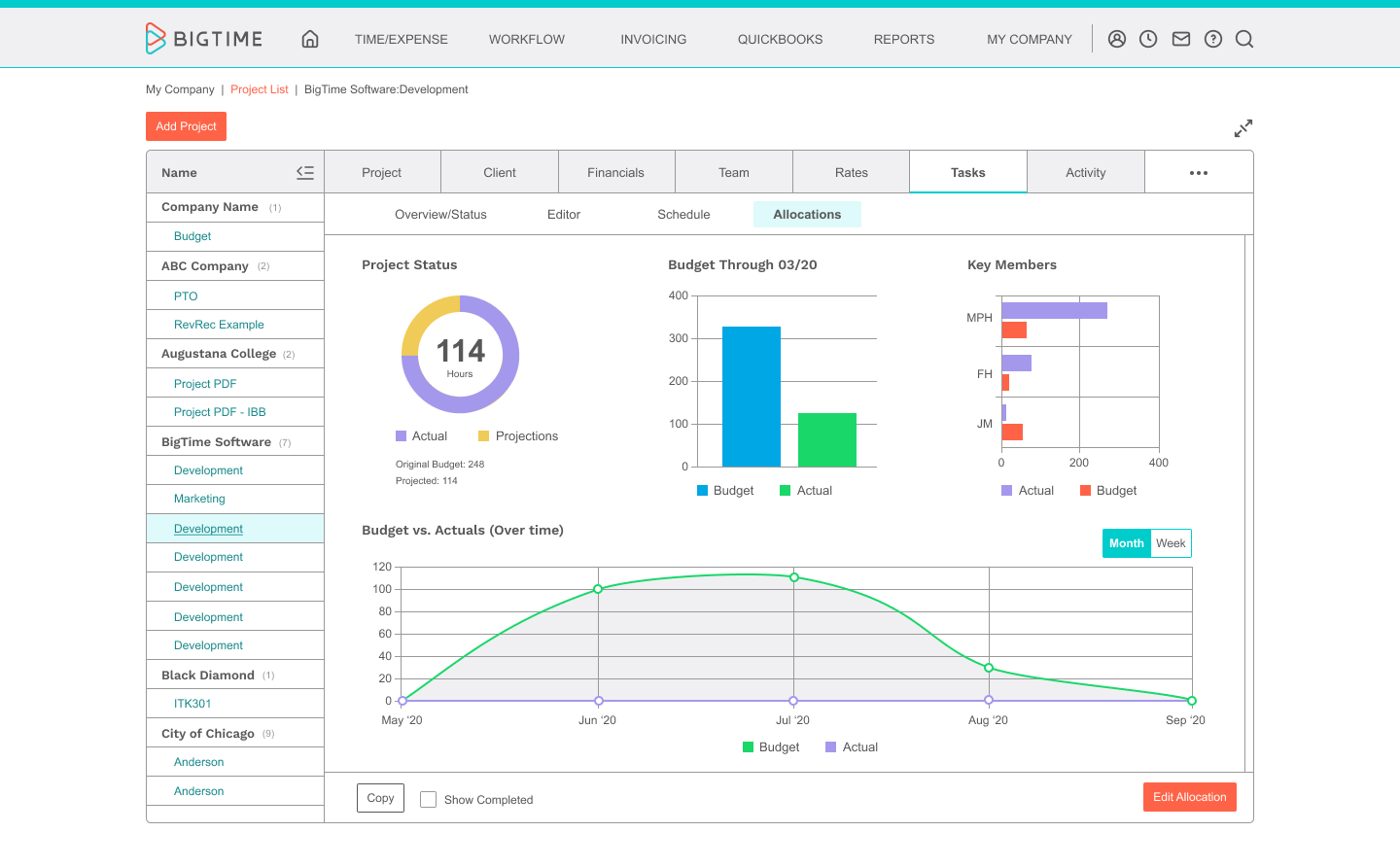Calculate Utilization Rate
When you accurately calculate utilization rate through BigTime, you create all kinds of opportunities to improve your business’s profitability.
SHOW ME HOW
Track smarter, not harder
Easily log time and expenses with personalized data entry options for your team's individual timesheets.
Bill fast and friendly
Quickly pull together professional-looking custom invoices and send to your clients without the hassle.
Avoid over/under scheduling
Always have an idea of you who working on what and reduce overall time on the bench.
Keep projects moving
Smoothly handoff work between teams and approval levels with custom workflows so you can manage your projects you way.
Plan ahead and on the fly
See your plans and analyze progress at a glance with dashboards, analytics, and reporting.
Connect your favorite tools
Seamlessly sync your current software with our deep integrations and full tech support from our team.
Better growth starts here.
LEARN MORE
Your consulting company makes money when your staff is doing work that a client is paying for. In some contracts the client pays for billable hours, and other jobs are done on a fixed bid. Even for fixed bid contracts, however, it’s important to know what the time utilization is. You need to know what percent of each employee’s hours goes directly to client work.
Good staff utilization metrics allow you to see how well your staff is deployed to deliver projects on time and within budget. If there are individuals whose utilization is too low, you know they are available to be assigned additional work. If a project has a lot of workers with a very high capacity utilization rate, it might be time to add some resources.
It’s a useful exercise for management to compare budgeted utilization rate with actual rate during various phases of the project. This discipline will improve project planning and help management set the ideal staffing levels early in the project.
It’s doubly useful if the management team has an integrated system with a utilization dashboard and an allocation dashboard. Then they can see at a glance where utilization rates are appropriate and where they miss the mark. They can quickly modify work assignments to achieve a better overall utilization rate.
At its simplest, utilization rate consists of billable hours divided by total hours. As a utilization rate example, an employee who bills 30 hours in a 40 hour week has a utilization rate of 75 percent. The challenge arises in determining which numbers to use in the formula, particularly the number used in the denominator. Is it a flat 40 hours per week? Is it the hours actually spent in the office? Does it exclude days off and other down time?
While the numerator in the utilization rate formula is more straightforward, it isn’t without difficulties. Have billable hours been captured accurately? What about the hour a staff member spent partly working on the project and partly on administrative tasks?
Utilization Rate Calculator
While the utilization calculation formula is simple, obtaining accurate numbers to use in the utilization rate calculator is more difficult. It requires some decisions about what will be included in available hours and what won’t.
Many experts make a distinction in occupancy vs utilization rate. In the call center world, some define occupancy rate as the number of hours a rep spends working with a client as a percentage of the number of hours they’re available to answer calls. In other contexts occupancy is sometimes defined as the percentage of hours being billed at a specific point in time. That is, what percentage of staff is doing billable work right now. In this scenario, utilization calculation involves an average utilization formula. Utilization looks at occupancy over time.
Some consultancy businesses aren’t particularly interested in this kind of occupancy calculation when applied to professionals delivering consulting services. What is important is that they understand their utilization over different types of timeframes. They need to know what utilization rate is over the phases of a project as well as over the entire life of a project. They must track overall company utilization and be able to compare utilization rates on different kinds of projects.
Businesses must choose the denominator they will use for total hours and be honest and consistent in its use. If you exclude paid time off and sick time, your utilization rate will be higher. If you use 40 hours per week as the denominator and most of your staff works more than that, some of your utilization rates may be over 100 percent. None of these choices is inherently right or wrong, but it’s critical to understand why you’re doing it the way you are. Even more important, choosing and gathering the numbers must be consistent across the organization.
How To Calculate Utilization Rate in Excel
Once you have the billable hours and total hours, there’s no mystery in how to calculate utilization rate in Excel. It doesn’t cost anything to use Excel, and, with or without macros, it’s not difficult to put together a system that combines billable and total hours from various sources. You can readily design a system that knows how to calculate utilization in Excel and display it by employee, by project and for the whole organization.
The shortcoming of an Excel solution is that the utilization rates are only as good as the numbers that go into them. With Excel, it’s difficult to put the edits and processes in place to ensure that the inputs, particularly the billable hours, are as accurate as they need to be.
A more reliable solution is a complete time tracking and project management system such as BigTime. Such a system has the controls that increase the accuracy of the inputted data. Easy input screens can capture billable hours on a daily basis. These screens are customizable to make time recording simple and obvious for professionals who want to do it quickly and get back to the work that they’re paid for.
In addition, BigTime offers process workflow that prompts managers to approve time entry. The billable hours numbers won’t be as good when there’s a delay and getting them approved and into the calculation formula. They’re more reliable when supervisors bring their extra set of eyes to the data and flag any input that seems unreasonable.
Unlike some less robust solutions, BigTime is not free. However, we do offer a free trial. You can find out for yourself how accurate and easy an integrated time and utilization system can be.
What Is a Good Utilization Rate?
It’s one thing to know how to calculate utilization, but it’s another to understand what the resulting utilization rate means for your organization. Many experts consider a number around 80 percent to be good, using total hours of about 2,000 a year (40 hours per week excluding holidays).
As you might expect, there’s variation in average employee utilization rates by industry. Some studies show IT services to run around 80 percent while legal and strategy consulting services go slightly lower. The relevant factor isn’t so much which industries have higher utilization. It’s that, regardless of what business you’re in, increasing your utilization rate makes you more cost-effective and boosts your profits.
You can track your utilization against the average utilization rate consulting firm in your line of business. The numbers are somewhat useful, but they don’t tell what assumptions other firms used or how accurate their billable hour tracking is.
It’s generally more beneficial to track your own rate and see how it varies over time and across different projects. There’s always going to be unbillable time, and how much there is depends on what other essential business functions you expect your people to perform.
Certain types of non-billable time are important and add value to the business. Examples are planning, R&D and taking care of the organizational culture. There’s other unbillable time that’s simply a necessity. A prime example is the administrative task of recording and approving time entry. Anything you can do to help your staff record hours accurately and with less focus taken away from their client work is a plus. That’s why a full-function time tracking and utilization system that makes the process easy and accurate is one of the best investments you can make.
Employee Utilization Rate Benchmark
What should your employee utilization rate benchmark be? What is productive utilization meaning for your company?
A utilization rate of 80 percent may be good, and a rate of 90 percent might be a benchmark that you strive for, but a rate near 100 percent suggests that you’re overworking your people. It may be time to hire more staff, take on less work or extend the time frame of some of your projects. On the other hand, a low utilization rate may mean that you simply don’t have enough work. It may also mean that your people are spending too much time on administrative tasks. It may imply that you’re not allocating your human resources efficiently, resulting in too many available resources sitting “on the bench.”
In the end, utilization rate is a measure of how efficiently resources are applied to the work at hand. It’s hard to optimize the way you organize work for your clients if you don’t know what your utilization rate is. If you have a history of projects with known utilization rates across their various phases, you have a powerful planning tool for new projects that come down the pike. You’ll be better able to forecast, to provide accurate estimates to your clients and to optimally assign resources as the projects get underway.
Time entry and utilization rate management shouldn’t be separate processes. Instead, they should be integrated into overall project management scheme. That’s why it's worthwhile to invest in a total project management package such as BigTime. When all aspects of project management are integrated, it takes less expense and effort to seamlessly capture billable hours and to leverage the wealth of utilization information that becomes available to you.



